The Caucasian Shepherd Dog or Caucasian Wolfhound is a breed of large guard dogs with a resolute, fearless character. They do an excellent job with herding and guarding activities. Loyal to one master.
Caucasian Shepherd Dogs are a nightmare of all hooligans and hunters for someone else’s property. Soft on the outside and harsh on the inside, these formidable giants have several virtues, among which the willingness to stand up for the owner and his material values is central. But one should not expect special emotionality, as well as pliability, from Caucasians. Any wolfhound is, first of all, a watchman and a guard, with an explosive character and his own views on life, and only secondly – a pet.
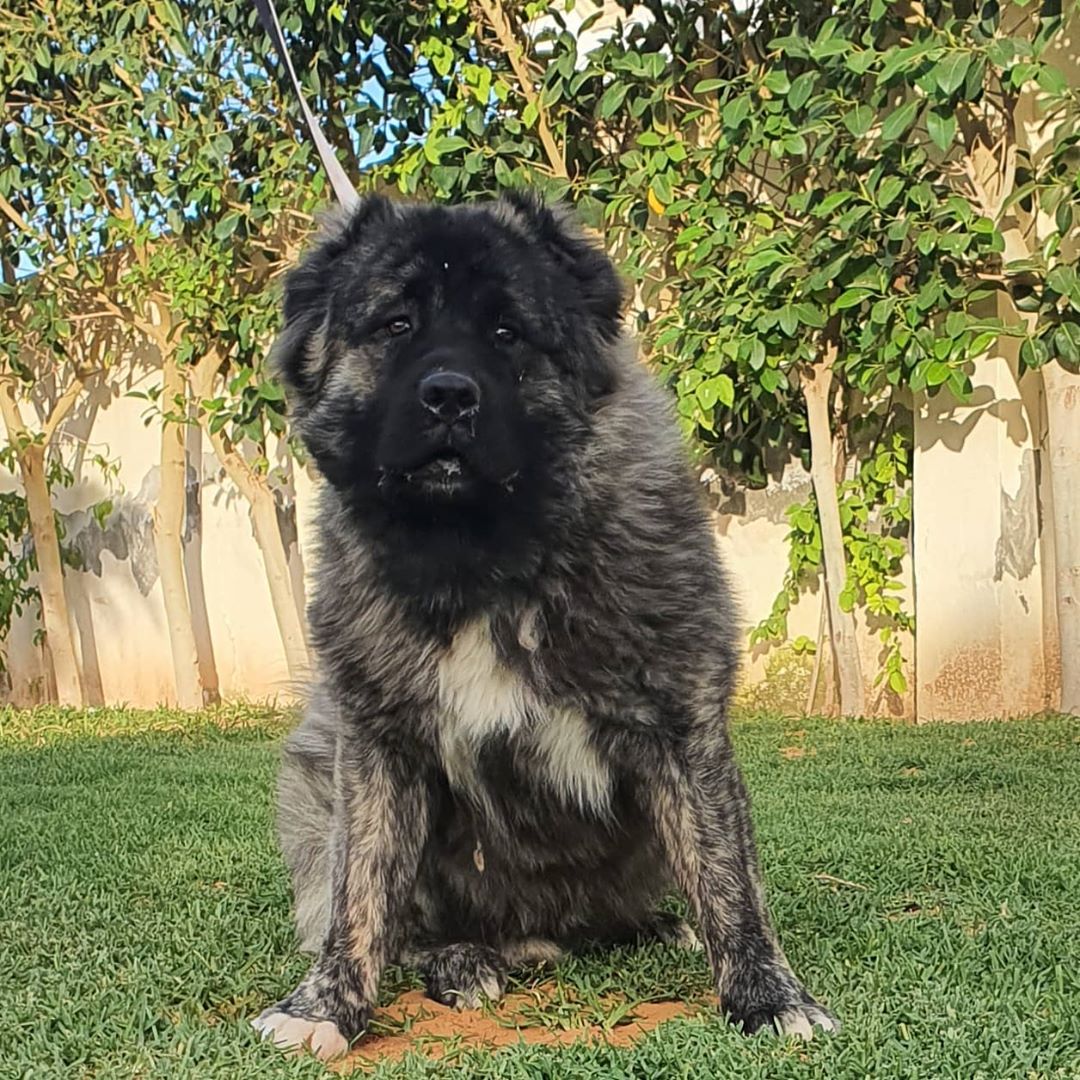
Caucasian Shepherd Dogs are among the most ancient canine “clans”, the history of which is counted for thousands of years. For example, the ancestors of today’s wolfhounds grazed sheep flocks in the foothills of the Caucasus long before the advent of Christianity. As for the origin of the breed itself, the Tibetan Great Danes are considered its founders, which in ancient China were used for baiting and fighting. Some experts call the homeland of dogs southwestern Asia, or rather, the Urartu-Ararat kingdom, where animals were in the service of cattle breeders and from where they began to disperse across adjacent territories.
An interesting fact: the ancient shepherds were the first “breeders” to whom the Caucasian shepherd dogs owe their outstanding watchdog instinct. It was they who were in charge of vicious animals and the selection of puppies, cultivating and successfully developing useful performance characteristics in them. For example, a real shepherd dog, in the understanding of Caucasian shepherds, had to have endurance and sufficient strength to deal with an attacking wolf. In addition, she has been prescribed unpretentiousness in food and insensitivity to sudden changes in air temperature.
The Caucasian War was the impetus for the appearance of shaggy “highlanders” in tsarist Russia. The participants in the hostilities brought dogs as live trophies, while none of the newly minted owners of shepherd dogs was eager to seriously breed the breed. Domestic breeders began to take an interest in wolfhounds only in the 30s of the last century, after the Nuremberg Exhibition, but their breeding research was interrupted by the Second World War, which destroyed the entire gene pool of Caucasians. To the slightest degree, it was possible to restore the breed in the USSR only by the beginning of the 70s. From about this time, consumer demand for Caucasian Shepherd Dogs began to grow.
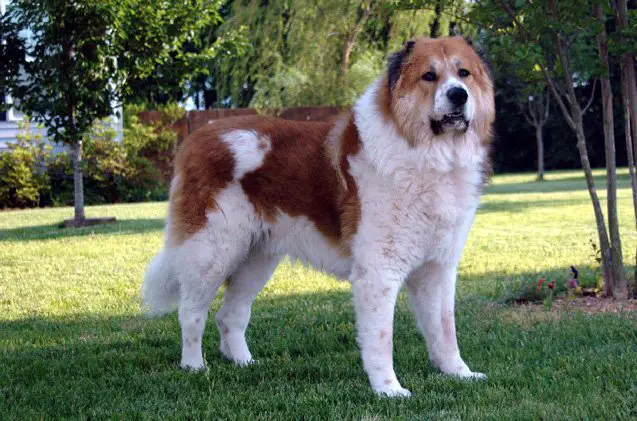
What the Caucasian Shepherd Dogs cannot be blamed in any way is the lack of charisma and external charm. Indeed, the muscular “highlanders” look very solid, if not monumental. Long-haired individuals with lush, almost bearish “fur coats” look especially colorful, giving the animals a resemblance to gigantic toys.
The minimum weight of a purebred Caucasian wolfhound male is 50 kg. However, most dogs do not stop at such modest indicators, often overcoming the bar of 70, and sometimes even 100 kg. Shepherd females are shorter and slimmer than males: the minimum permissible weight of a girl is 45 kg, with a height of 64 cm. But, as with any rule, there are also exceptions here.
The head is wedge-shaped, with a flat forehead and raised cheekbones. The skull of the Caucasian Shepherd Dog looks massive, but the brow ridges and the occipital protuberance in the representatives of this breed are poorly expressed. The muzzle is broad, tapering smoothly from base to nose and ending in a strong chin. The stop is noticeable, but without a sharp transition.
The lips are dry, fleshy, with good pigmentation.
The teeth are massive, white, the incisors are closely spaced. Both scissor and straight bite types are acceptable. A complete set of teeth is desirable (42).
The bridge of the nose is flat, wide, with a large lobe that does not go beyond the muzzle. The nostrils are moderately open. Ideally, the lobe should be black, but an exception can be made for skewbald and spotted coats.
Caucasian Shepherd Dogs have rounded eyes, located slightly obliquely and at a fairly large distance from each other. The eyes of the representatives of this breed are attentively focused, evaluating. The breed standard iris colors are all shades of brown, including dark brown and light hazel varieties.
The ears are small, drooping, and set high. The auricle is densely muscular with the inner part pressed to the head. Both cropped and natural ear shapes are allowed.
The neck is short, dense, with a developed nape.
The body of the Caucasian Shepherd Dog is large, elongated, with a wide back, short loin, and a taut belly. The croup is slightly rounded, elongated, with a slight slope at the base of the tail. The rib cage is deep, noticeably stretched in breadth.
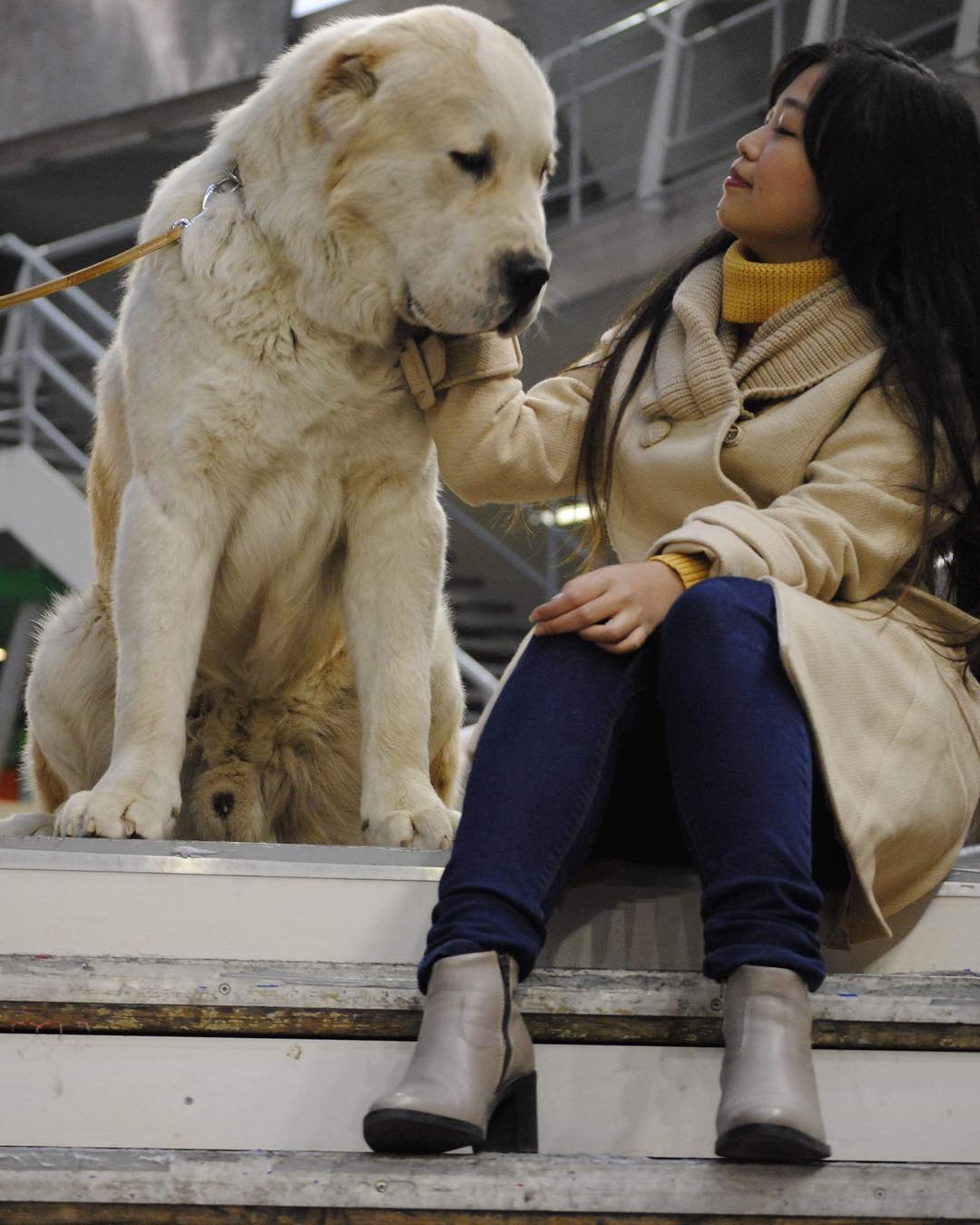
The tail is sickle-shaped, set high. In a calm animal, it hangs down, reaching the hock joints, in an excited animal, it is raised above the backline.
The front and hind legs are straight. The wide shoulder blades pressed to the body pass into strong, muscular shoulders. The pasterns are large and short. The thighs of the Caucasian Shepherd Dogs are strong, “pumped up”. The hock joint is dry, broad, and strong. The paws of all four limbs are large, arched, with fingers compressed into a ball.
Coarse hair, noticeably behind the body, with a pronounced undercoat. The average length of the awn and undercoat is 5 cm. On the ears, the hair forms amusing tassels, and in the chest area, it turns into a chic mane. On the back of the front paws, the hair is gathered into long feathers, the hips of the dog are hidden under soft downy “pants”. The tail is abundantly covered with hair, which makes it seem thicker than it really is. Depending on the length and structure of the coat, there are three types of Caucasian wolfhounds:
- smooth-haired;
- long-haired;
- intermediate.
Among buyers, individuals of the second type are in high demand. Of the entire tribe of Caucasian Shepherd Dogs, it is they who have the most striking and memorable appearance. The representatives of the first variety are easily confused with Alabai because of their short undercoat and similar build.
All types of piebald, solid and spotted colors are allowed, except for any combination of black.
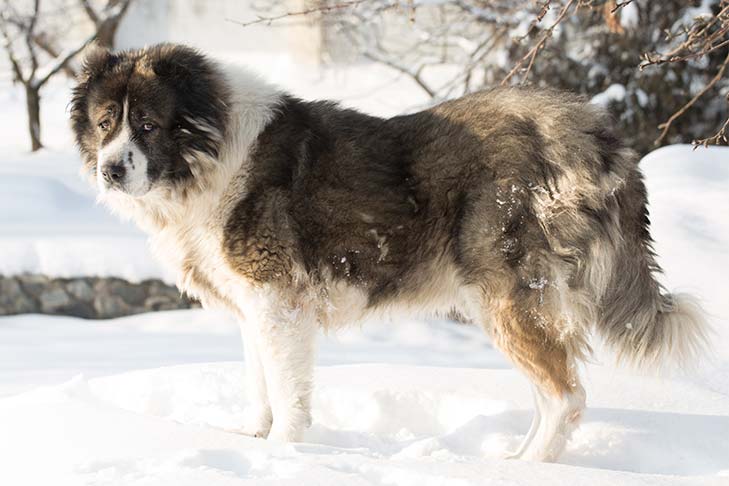
Caucasian Shepherd Dogs are considered defective, whose anatomical features do not fit into the framework of the official standard. An animal can be disqualified from the competition if it has the following developmental defects:
- cryptorchidism;
- insufficient growth (dwarfism);
- non-standard bite;
- brown-brown color and any of its variations;
- blue and black coat colors, as well as any combinations thereof;
- docked tail;
- the blue or grayish tint of the eyelids, lobes, and lips;
- entropy;
- eyes of different shades, as well as uneven color;
- missing one or more teeth (exceptions: third molars and first premolars);
- brown tint of the eyelids, lips, and nose.
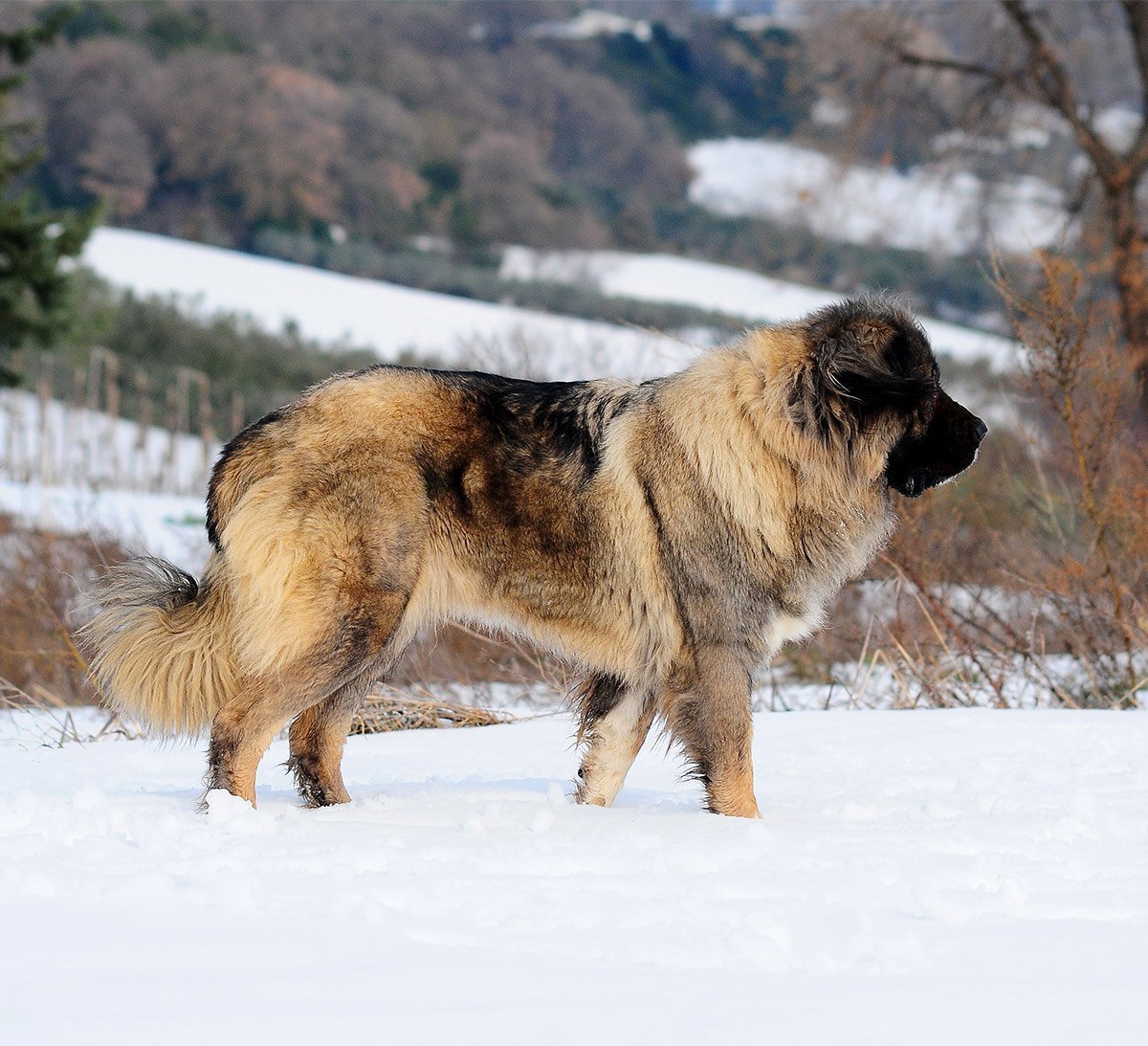
Having a rather pleasant, and sometimes frankly sweet appearance, Caucasian wolfhounds remain very serious pets, the owners of which will have to constantly keep their finger on the pulse. These harsh brutal are focused on protecting a person and his property. Not a single stranger, even with the most insinuating manners, will be able to get into their confidence. Intimidation and threats do not work on dogs either, so if you are looking for a first-class watchman with the makings of a professional bodyguard, the brave “highlanders” will not disappoint you.
Caucasian Shepherd Dogs slightly “thaw” only when they are in the circle of their beloved people, which is generally not surprising. Endless dedication to home and family is one of the key characteristics of this canine tribe. True, to earn the trust of a pet, you will have to work hard on the image of a strict and fair owner since the cult of strength for shaggy “security” is not an empty phrase.
Most Caucasian Shepherd Dogs are smart, balanced, and quite adequate pets, with a hardened character. For example, they willingly spend time with children, taking part in their games and antics. However, do not try to raise an all-forgiving nanny from a shaggy guard: a shepherd’s job is to protect a person, not serve him as fun.
Despite the natural severity, “Caucasians” are not averse to sharing the territory with some domestic animals. As for living with other dogs, the best company for a shepherd dog will be a representative of any of the decorative breeds. The miniature size of the four-legged creature is a kind of guarantee of the peaceful coexistence of pets, while in a larger specimen, the Caucasian wolfhound will immediately feel a rival, whom it will try to crush under itself.
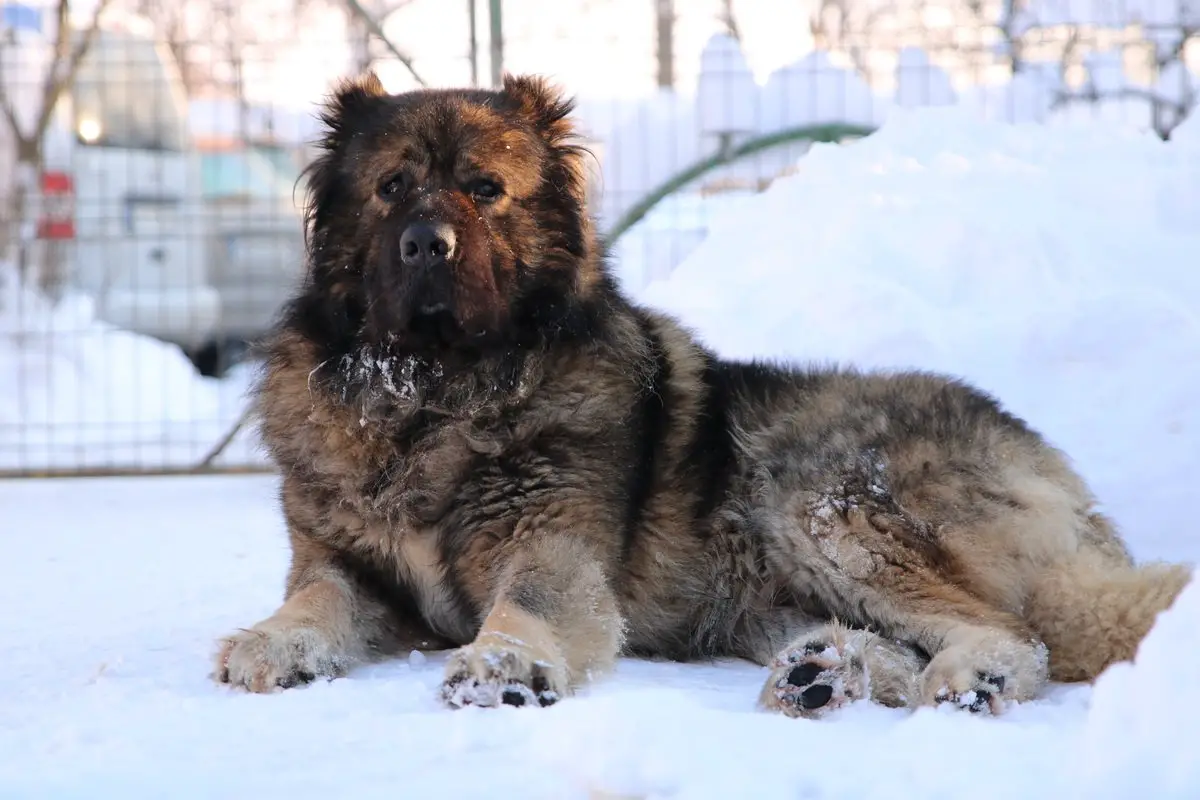
There are many myths about the bloodthirsty nature of the Caucasian Shepherd Dogs. It is important to understand that no dog is born a killer. But it may well become her as a result of improper upbringing. An owner who neglects the training and socialization of a pet and does not know how to maintain his own authority runs the risk of raising an uncontrollable and ferocious creature, with whom he will eventually have to part. In addition, when bringing a little puffy puppy to the house, not every buyer is aware of who this cute will transform into in a year. Keep in mind that growing up, Caucasian wolfhounds completely get rid of “childish” character traits, turning into self-confident and rather stubborn guards.
The upbringing and socialization of the puppy begin from the very first days of his appearance in the house. Particular attention should be paid to individuals living in the city. The dog should not be afraid of public transport, growl at every passer-by, and chase stray cats. Since the Caucasian Shepherd Dogs are slowly maturing breeds, the first teams begin to train them at the age of 5-6 months. By the year, the animal must understand and execute the following commands:
- “You can’t!”;
- “Sit!”, “Stand!”, “Lie!”;
- “Nearby!”;
- “Teeth!”;
- “Muzzle!”;
- “A place!”;
- “To me!”.
The Caucasian Shepherd Dog is a personality dog, so do not try to persuade him to useless errands over a thrown ball or plate. Such activities cause a feeling of bewilderment in the animal: why waste energy in vain if it can be saved for a possible throw at the enemy? The innate stubbornness and high level of intelligence prevent the Caucasian wolfhounds from fully immersing themselves in the learning process. Surprisingly, but a truly effective method of training shaggy “highlanders” has not yet been invented. Moreover, with them, even the standard OKD (General Course of Training) gives very inexpressive results.
The qualities that the owner of the Caucasian Shepherd Dog will need in the process of training a pet are patience and endurance. In addition, it is necessary to establish close emotional contact with the animal, since the representatives of this breed are distinguished by developed intuition and easily determine the mood of the owner by his facial expressions and voice. Do not be surprised, but the training of the Caucasian Shepherd Dog can take 2-3 years due to the dog’s dislike of repetitions. And it’s not about the complexity of nature. The animal simply does not see the point in the monotonous repetition of the same exercise, because it is much wiser to save strength for more interesting activities.
Do not be fooled by the advice of “seasoned” dog owners, who claim that Caucasian Shepherd Dogs need to be beaten periodically so that they understand who is “the boss”. You will not achieve anything but anger and uncontrollable aggression. Yes, it is necessary to treat a pet strictly, and sometimes quite harshly, but applying corporal punishment to it is the last thing. Bribery with sweets and caresses in a particular case is also not good. Sheepdog is not a vulnerable lapdog and does not need your favors.
Like most large breed dogs, Caucasian wolfhounds tend to dominate, so it is important to catch the moment when the animal begins to show leadership habits to further correct its behavior. It is not difficult to understand that your pet has gained strength and is preparing to crush the household. Usually, such a dog begins to neglect the rules of etiquette: to beg for food; run into the house in front of the owner; walking on a leash, pull out and drag a person along. Some individuals show aggression by snarling at family members.
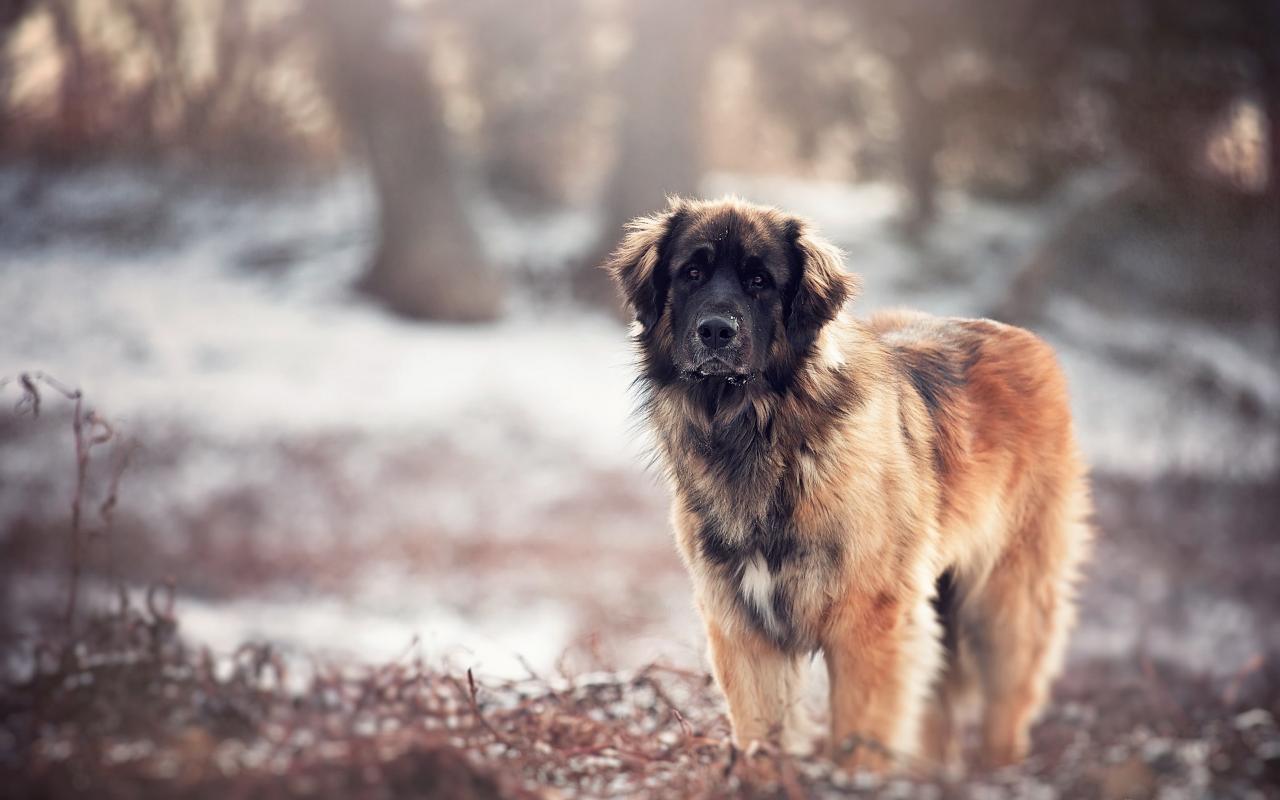
No matter what the advertising of cynological schools promises, the ZKS courses for the Caucasian Shepherd Dog are a pure formality. These harsh giants are born watchmen and bodyguards, and they do not need to be taught the correct reaction to any “newcomer” who has violated the boundaries of the master’s domain. If you still want your dog to learn the intricacies of protective guard service, get ready for the fact that during training your pet will not always demonstrate excellent results. So, for example, an animal can simply ignore the provocation on the part of the trainer, and the explanation for this behavior is simple: the dog does not see the need to resist a fake threat.
Ideally, ZKS training is carried out in the territory that the pet considers it’s own. Training on playgrounds and wastelands will disorient the dog. The animal does not understand why to guard an uninteresting and completely unfamiliar place that does not belong to it. In addition, many of the skills taught by the ZKS course contradict the nature of the Caucasian Shepherd Dogs. In particular, most wolfhounds do not pursue an enemy who has taken to flight, but the protective guard service requires the opposite from the animal.
Caucasian Shepherd Dogs also do not like to practice skills on a sleeve stuffed with cotton wool, preferring to bite into the open areas of the instructor’s body, which is why many dog handlers do not undertake to work with the breed. The wolfhounds do not grab their teeth but tear out the intruder who has infringed on the health of the owner of his property, and titanic efforts will be required to wear them from this habit. At demonstration competitions, dogs can also be cunning and include an energy-saving mode. Such work half-heartedly indicates that the animal has managed to assess the frivolity of what is happening and does not consider it necessary to give all the best for the sake of some kind of assessment.
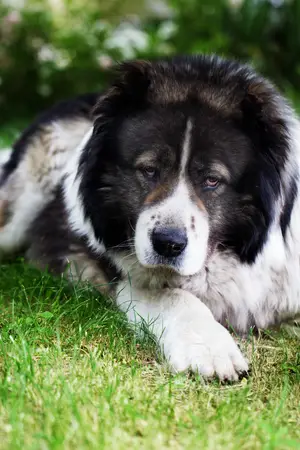
The Caucasian wolfhound is a terrible owner who is truly happy only when he has something to protect. Accordingly, the best home for a pet will be a cottage with a courtyard and a plot of land. These shaggy brutes are not sensitive to temperature extremes, so they feel quite comfortable in a spacious aviary. Keeping Caucasian Shepherd Dogs on a chain is also quite acceptable, but it should be a light chain up to 2.5 m long.
The settlement of a “Caucasian” in a city apartment is extreme for a very big fan, which is practiced only by the most stubborn lovers of the breed. Yes, shaggy watchmen do not suffer from hyperactivity and do not arrange pogroms, but they cannot fully realize their protective qualities in such conditions. You should not discount the difficulties with the placement of the pet. The Caucasian Shepherd Dog is a large breed and its representatives need a decent place. It is not enough to provide the dog with a spacious bed and a bowl for food; it is also necessary to provide an excellent view of the premises entrusted to it. In addition, opening the door to each guest, the owner will have to carefully monitor the reaction of his pet: a stranger who has crossed the threshold of private property is enemy number 1 for shaggy bodyguards.
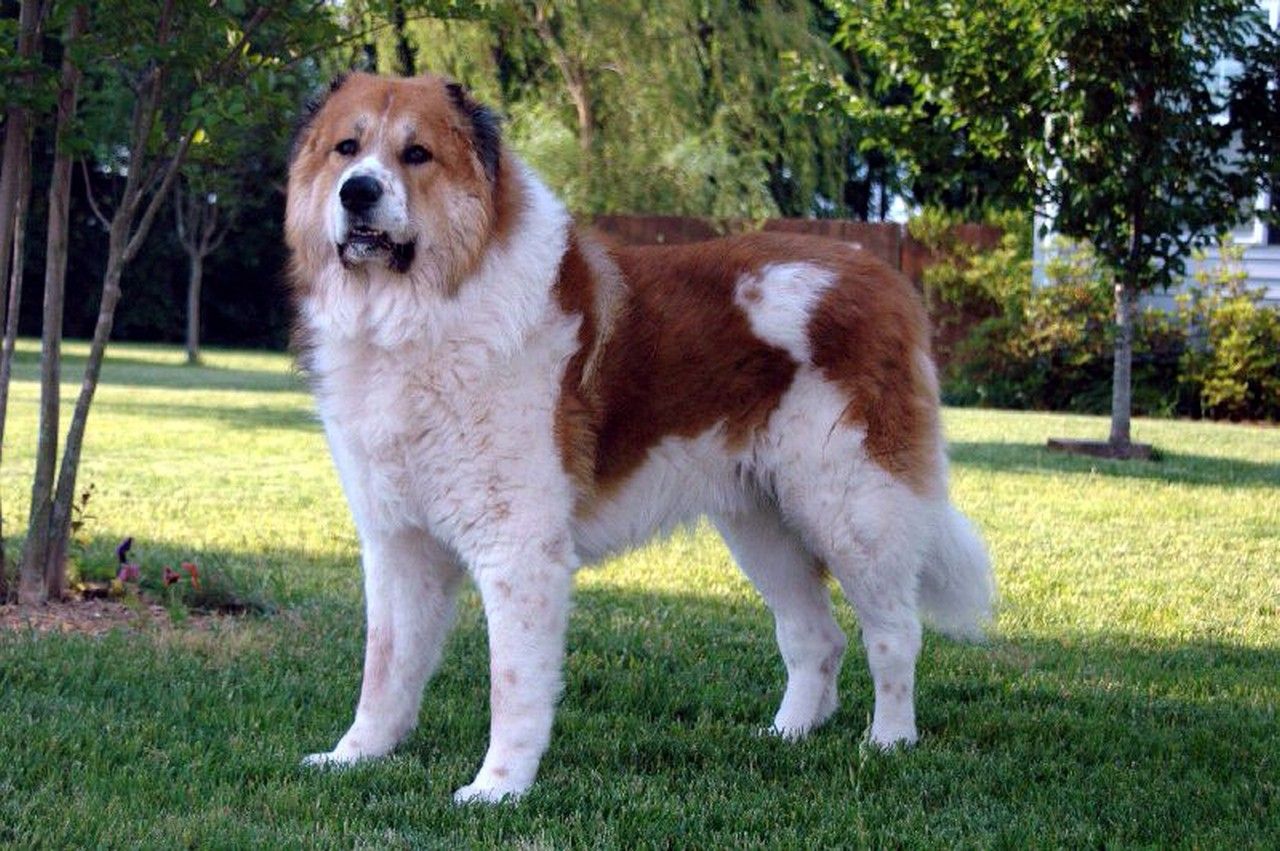
You don’t need to be a cynological guru to understand: Long-haired Caucasian Shepherds require more careful care than their short-haired brethren. The soft hair of shaggy individuals gets tangled, and in winter it absorbs snow moisture, so long-haired wolfhounds are periodically combed and trimmed (the hair on the legs and paws is shortened). Sheepdogs are washed as needed, for example, when the animal gets dirty in the mud or has got blood-sucking “tenants”. At the same time, it is better not to refuse dogs to swim in open reservoirs, especially since they are wonderful swimmers.
In the spring and summer, “Caucasians” suffer from ear mites, so the ear funnels should be examined and cleaned more often during the warm season. If the animal shakes its head and scratches its ears, see your veterinarian who will understand the problem. Perhaps, it is not ticked that are to blame, but otitis media.
The eyes of the Caucasian Shepherd Dogs are problem-free, but in some individuals, there is a congenital pathology in the form of a loose eyelid. As a result: an infection from the outside gets into the eyes, causing inflammation. You can deal with the problem with a decoction of chamomile or veterinary drops.
“Caucasians” love to gnaw bones at their leisure, or even wooden boards, the remains of which get stuck between their teeth. So buy tweezers in advance to free your pet’s jaws from food and wood debris. To remove plaque, which periodically appears in every dog, you can use a special brush and veterinary paste.
Earlier, the ears of the Caucasian Shepherd Dogs were subject to mandatory cropping. The procedure was carried out not for aesthetic purposes. In this way, ancient breeders tried to protect pets from blood loss, because the longer the ear, the greater the risk of injury to the animal in the fight. Today this requirement has been removed, but according to an old memory, most nurseries continue to practice this surgical operation.
The ideal age for cropping the ears of the Caucasian wolfhound is the first day of life. On the 5th day after birth, the ear tissue thickens, and it becomes more difficult and more dangerous to work with it, as there is a risk of blood loss. For owners who have purchased a puppy with normal ears, but would like to stop them, it is better to wait until the dog is one year old. At this age, the animal can undergo general anesthesia, under which the procedure is usually carried out.
Important: do not play know-it-all doctor and do not try to clip the ears of the Caucasian Shepherd Dog yourself. Each animal has a unique shape, thickness, and size of ear, so only a veterinarian or an experienced breeder can determine the principle of “cutting” this part of the body.
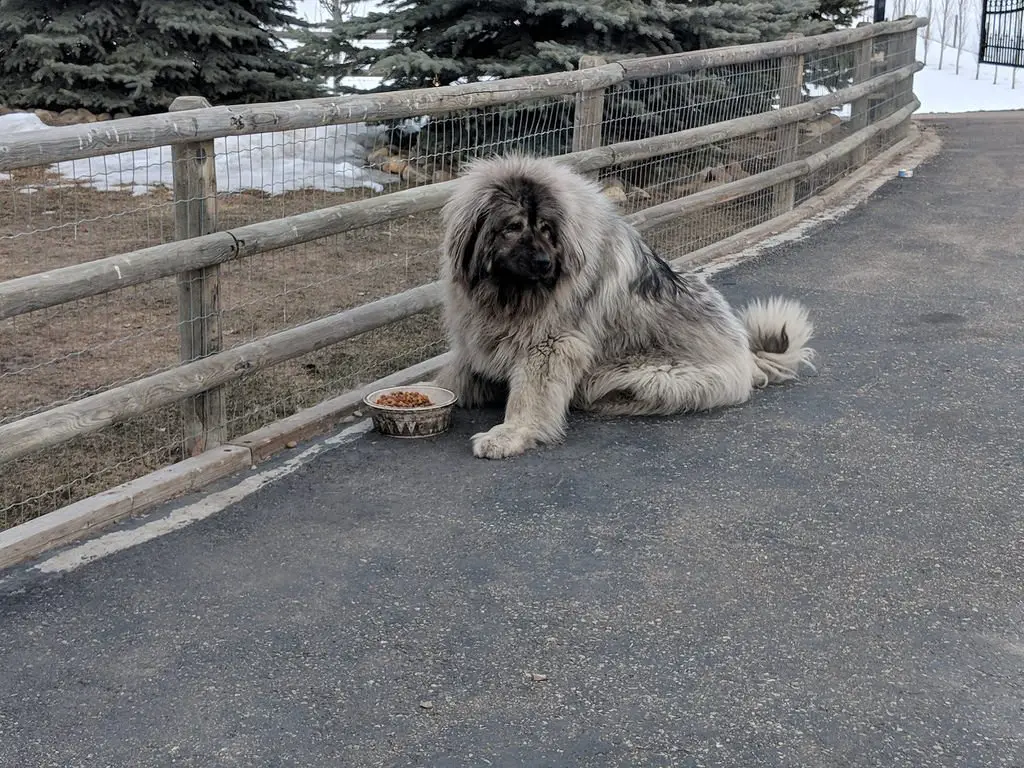
It is, of course, necessary to walk the “Caucasians”, but it is not at all necessary to spend half a day with them on the street. Keep in mind that too long promenades are not a joy for shaggy security guards, as they prefer to save energy for more serious matters. In crowded places, in the veterinary clinic, and on public transport, a muzzle is required. Dogs do not like this accessory, so it is better to teach pets about it from puppyhood. To go out into the world, the Caucasian Shepherd Dog will need two leashes: a short one (from 1 to 1.5 m) to keep the animal at the feet of the owner, and a long one for walking.
Caucasian Shepherd Dog Walking Rules
- On the street, the dog is taken out exclusively on a short leash and in a muzzle.
- It is strictly forbidden to walk Caucasian Shepherd Dogs by children under the age of 14, as well as by persons under the influence of drugs and alcohol.
- If the animal is walking in a private fenced area, it is necessary to notify passers-by. The inscription: “Caution, angry dog!”, Attached at the entrance to the territory, will do.
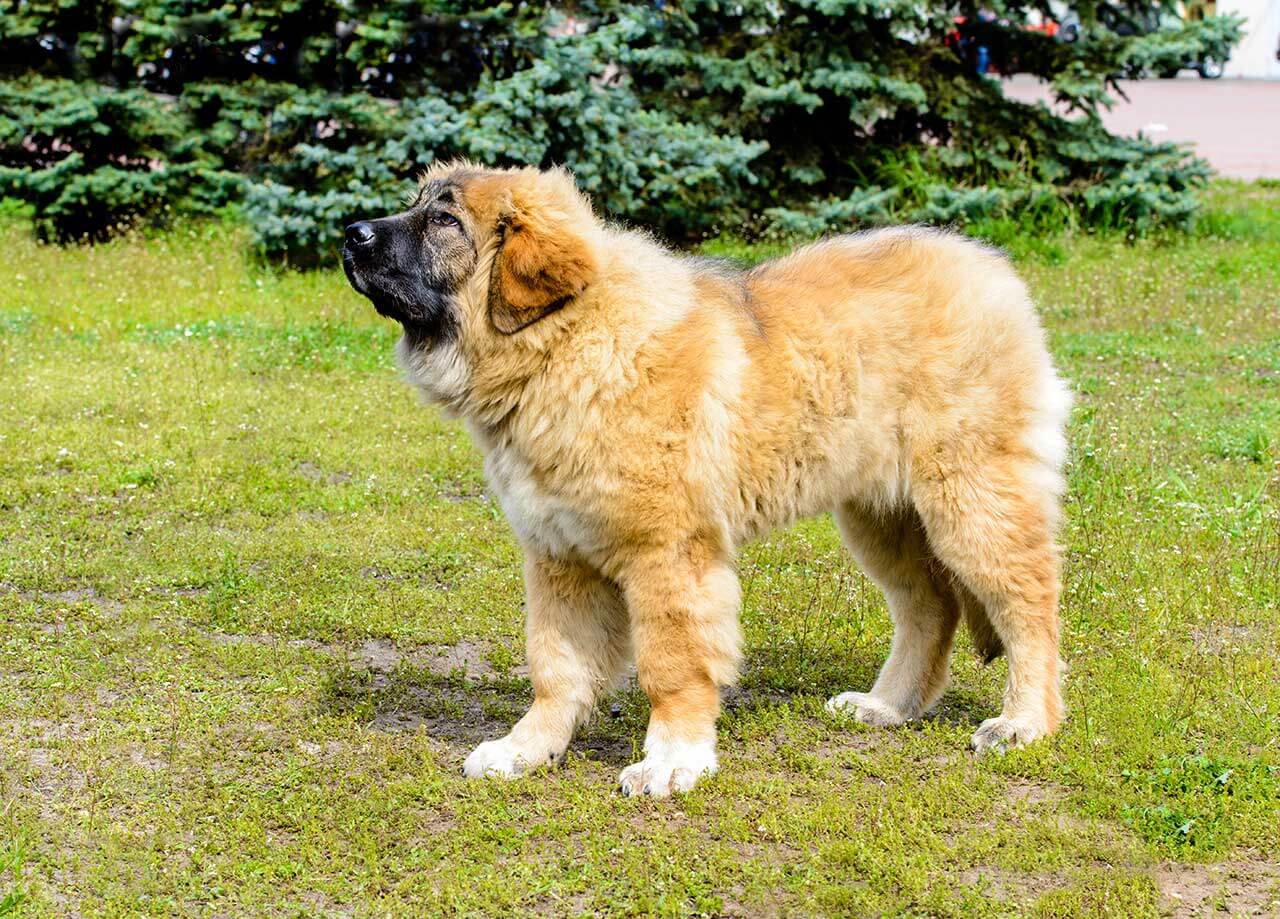
Compared to representatives of other large breeds, the Caucasian Shepherd Dogs are small toes. 35-45 g of natural food or 10-15 g of “drying” per kilogram of animal weight – this is the daily feed intake for an adult. Shepherd dogs have a high metabolism, which allows them to “squeeze” the maximum of nutrients from a relatively small portion. In addition, their digestive system is excellent at absorbing milk – a product that can provoke intestinal upset in most dogs. Here, however, it is worth making an explanation: only those individuals who have been accustomed to it can digest whole milk. If such food did not appear on the dog’s “table” for several months, and then suddenly returned, prepare for diarrhea.
The most important product in the diet of the Caucasian Shepherd Dog is meat, and its rough varieties: horse meat, lean beef, lamb. Offal and fish (mackerel, horse mackerel) are also not excluded. It is supposed to dilute animal proteins with cereals, as well as fruits and vegetables. Cereals (mainly rice and buckwheat) must be thoroughly boiled, otherwise, the dog’s stomach will not cope with them. You can cook cottage cheese for your pet: heat a liter of milk on the stove and, when boiling, add 4 tbsp. l. calcium chloride. As a vitamin supplement, apple and carrot salads with the addition of oil and banana puree are suitable.
In food, Caucasian Shepherd Dogs are picky and willingly absorb everything that the owner gives them. Experts recommend not to accustom your dog to a special variety of food and delicacies, since representatives of this breed are extremely economical in energy consumption and do not always have the opportunity to “burn” extra calories. So if your pet begins to suffer from a loss of appetite, do not be alarmed and do not try to force-feed him. It’s just that the dog decided to arrange a fasting day, thus getting rid of excess energy reserves.
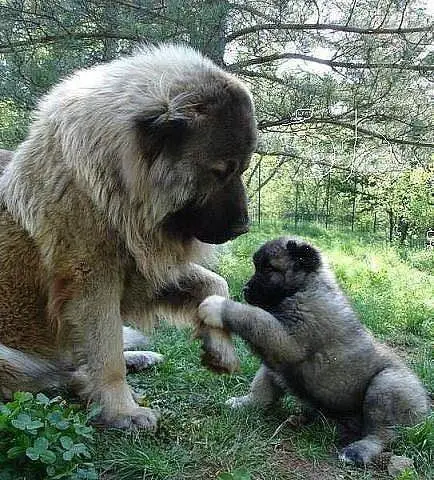
The Caucasian Shepherd Dog is a healthy and hardy breed with good immunity. Of the genetic diseases, they are seriously annoyed only by dysplasia of the hip joints and atrophy of the optic nerve. Less commonly, dogs are diagnosed with bursitis and degenerative myelopathy. You should not discount viral infections, which are especially susceptible to individuals who are in aviary content.
Due to a sedentary lifestyle and lack of exercise, many older animals gain extra fat, which ultimately leads to diabetes. Lack of physical activity can play a bad joke with the joints of the Caucasian Shepherd Dog, provoking the development of arthritis.

How to choose a puppy?
Immediately decide who exactly you need: a pet, watchman, and bodyguard, or the future successor of the Caucasian Shepherd Dog family. If you are planning to take the animal to a home with children, it is better to opt for females who are more good-natured and more willing to learn. But keep in mind that “for health” the girl will have to be allowed to have offspring at least once.
From the males of the Caucasian Shepherd Dog, excellent guards are obtained. But since the character of the boys is more domineering, it is easier for them to crush an inexperienced owner. So, before settling a shaggy male brutal in your house, think carefully if you have enough endurance and strength to educate him as a defender, and not a fierce aggressor.
When choosing a future caretaker in the nursery, pay attention to his behavior. Active and communicative puppies have the maximum potential. From cocky and pugnacious kids, wayward leaders grow, whose temper can only be curbed by a strict master. Remember your puppy’s health as well. Animals that are kept under the correct conditions should show no signs of inguinal or umbilical hernia. Cropped ears and the absence of dewclaws are signs that the breeder is responsible for his occupation and monitors the health of the wards.
Note: you can check the condition of a Caucasian Shepherd puppy with a simple test. Bring a piece of raw meat to the dog’s nose – a healthy pet will react to this action with lightning speed and will try to grab a treat.
